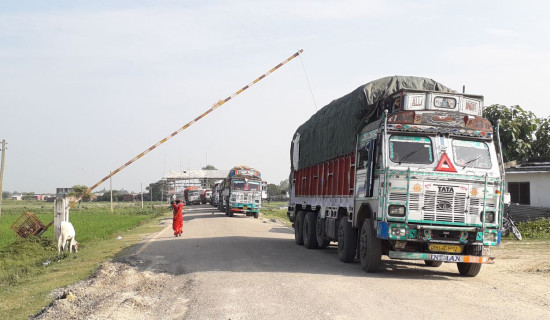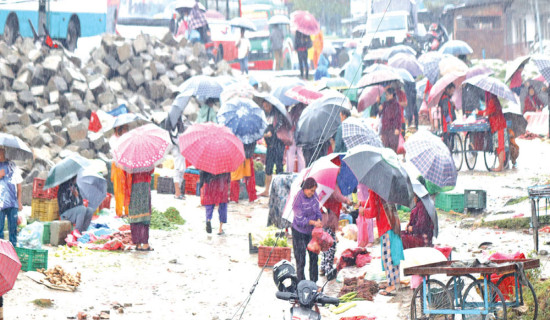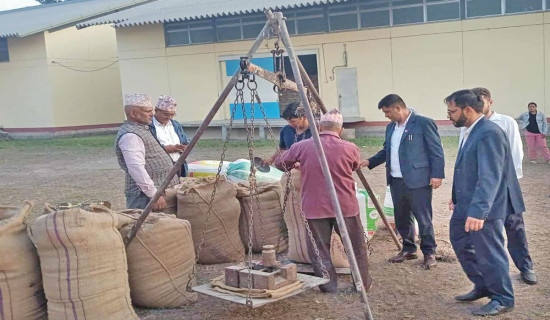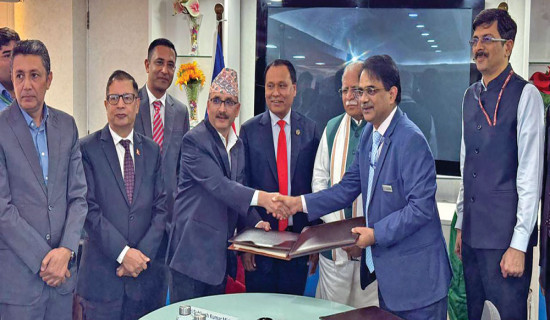- Saturday, 8 November 2025
Consumption occupies over 92% share in GDP
Kathmandu, May 27: The government has presented the Economic Survey of fiscal year 2023/24 in the meetings of the House of Representatives (HoR) and National Assembly separately on Sunday.
Tabling the Economic Survey 2023/24, Finance Minister Barsaman Pun said that economic and social indices of the country were improving.
He said that the country's economy would expand by 3.87 per cent due to the expansion in the agriculture and service sectors amid the contraction in the manufacturing industries and the construction sector.
In the last fiscal year, the economic growth was limited at 1.95 per cent.
In the current fiscal year, the economic growth rate of all provinces is expected to improve comparatively.
According to the survey, the economic growth of Gandaki, Bagmati and Lumbini provinces will be higher than the national average economic growth of 3.87 per cent during the current fiscal year. The government has estimated that Nepal's GDP will attain the size of Rs. 5,704.87 billion in the current fiscal year 2023/24.
The production of agriculture sector is expected to improve due to increase in winter crops and cash crops and livestock production. Under the non-agriculture sector, the production of sectors other than construction and manufacturing industries is expected to increase.
As a result, the production of the agricultural sector is expected to increase by 3.05 per cent and non-agricultural sector by 3.75 per cent in the current fiscal year.
In the last fiscal year, the production of agricultural and non-agricultural sectors increased by 2.76 per cent and 2.13 percent respectively.
Even though around 62 per cent of the total households are engaged in agriculture, the contribution of the agricultural sector to the Gross Domestic Product has been decreasing continuously in the past years.
The contribution of agriculture, industry and service sector to the GDP of the current fiscal year is estimated to be 24.09 per cent, 13.0 per cent and 62.90 per cent respectively.
In the last fiscal year, the contribution of agriculture, industry and service sector to the GDP was 23.92 per cent, 13.60 per cent and 62.48 per cent respectively.
This shows that with the change in the structure of the country, Nepal’s economy has been gradually transformed from agriculture to a service-oriented one.
The share of gross consumption in GDP has been high.
According to the survey, the gross domestic consumption to GDP ratio is expected to be 92.4 per cent in the current fiscal year.
The share of gross domestic savings in GDP was 7.4 per cent in the last fiscal year 2022/23 and it is expected to reach 7.6 per cent in the current fiscal year.
The total investment has not increased as expected due to the inability to increase capital expenditure and not increased credit flow.
According to the survey, total investment in the current fiscal year is expected to increase by 2.8 per cent to reach Rs. 1,741.48 billion.
The consumer price inflation has moderated over the last few months due to the policies adopted by most of the countries to control prices.
Even in Nepal, as a result of the measures taken for price control, the average consumer price inflation remained at 6.08 per cent by mid-March 2024.
PCI increases to USD 1,456
The per capital income (PCI) has been increasing gradually over the years. The per capita national income is estimated to reach US$ 1,456 in the current fiscal year. In the last fiscal year, per capita national income was USD 1,405.
The survey shows that the income of Nepalis has increased by 3.6 per cent in one year.
During the review period, the estimated per capital GDP is USD 1,434 and the estimated per capita national disposable income is USD 1,843.
Still, 20.27 per cent of the population in Nepal lives below the poverty line. The reports found that poverty was higher in rural areas than in urban centres. While in rural areas, the prevalence of poverty is 24.66 per cent, it is 18.34 per cent in urban areas.
Public debt mounts to Rs. 2,388 billion
The total outstanding debt of the government of Nepal has reached Rs. 2,388.26 billion as of March 13, 2024.
Out of total debt, external debt amounts to Rs. 1,202.73 billion and domestic debt comprises Rs. 1,185.52 billion.
The share of external public debt to the total outstanding debt is 50.4 per cent while the share of domestic debt is 49.6 per cent.
The federal government has mobilised debt of Rs. 218.87 billion, including Rs. 163.13 billion under domestic borrowing by mid-March 2024.
18,755 employer organisations listed in SSF
The number of employers and workers registered in the Social Security Fund has been increasing every year.
By mid- March 2024, a total of 18,755 employer organisations have been registered in the Social Security Fund (SSF).
Until this period, almost 1.2 million workers, including domestic and foreign workers, have been registered in the Social Security Fund.
By mid-March 2024, the number of cooperatives reached 31,450 and there are 7.38 million shareholders.
During the review period, the cooperatives have mobilised Rs. 478.11 billion and disbursed credit of Rs. 405.3 billion.
Only 28 km road added
In the eight months of the current fiscal year, the federal government has constructed 28 KM of road while 190 KM road is gravelled and 189 KM is black-topped.
Total length of national highways and roads constructed under the federal government has reached 34,267 KM. Of them, 53.2 per cent are black-topped, 22.5 per cent concrete and 24.3 per cent unpaved roads.
Meanwhile, with the continuous development of information technology, the access to information technology of the general public has been expanding.
Country moving towards self-reliance in energy
Due to the policies adopted in the last few years, hydropower generation has increased and the country has been moving towards self-reliance in the energy sector.
By mid-March 2024, the access to energy has reached 97.7 per cent of the population. As of mid-March 2024, the total installed capacity of renewable energy is 3,060 MW.
FDI approval reaches Rs. 478.85 billion
According to the Economic Survey 2023/24 made public by the government, foreign direct investment of Rs. 29.13 billion has been approved by mid-March 2024.
As of mid-March 2024, foreign investment worth Rs. 478.85 billion has been approved. It is estimated that around 322,000 jobs will be created by these industries.
Similarly, industries with the commitment of investments worth Rs. 5,011.96 registered in the Investment Board Nepal, Department of Industries and Cottage and Small Industries Development Committee have been approved as of mid-March 2024.
35,143 people get free health services
Under the Deprived Citizen Treatment Programme, a total 35,143 citizens have received free health services for the treatment of serious diseases such as cancer, heart and kidney disease during the first eight months of the current fiscal year.
By mid-March 2024, the number of families covered by health insurance is 2,395,000, while the total insured number is 7.72 million. Similarly, 3.621 million people have been received by health insurance during the review period.
Progress in SDGs positive
The government said that the progress achieved by Nepal in terms of sustainable development goals (SDGs) is positive.
The average achievement of SDGs target of 2022 is 58 per cent and 41.4 per cent of the target of 2030.
In sum, the country will achieve 60 per cent progress of the SDGs by 2030 based on the present rate of progress.
















